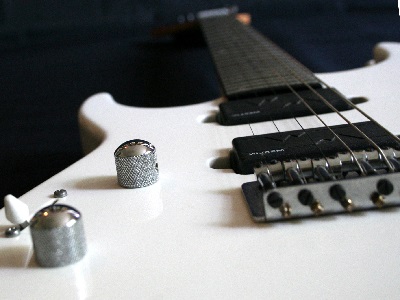Understanding How the Selector Switch Works
 So there’s a little switch, on the guitar, and what’s it does? No, this isn’t the opening line to some awful joke. That little switch on your guitar does something, but many guitarists don’t understand exactly what. Sure it makes the guitar sound different, but what does it actually do?
So there’s a little switch, on the guitar, and what’s it does? No, this isn’t the opening line to some awful joke. That little switch on your guitar does something, but many guitarists don’t understand exactly what. Sure it makes the guitar sound different, but what does it actually do?
That little switch does a lot, in fact. It controls your pickups. Now, that may be a little extreme, but it controls which parts of your pickups are doing what.
There are two kinds of switches; a three way guitar pickup selector switch, and a five way pickup selector switch. Both do the same exact thing, only within a different range. The three way switch changes between your bridge hum bucker, your middle pickup, and your neck hum bucker. But what if you only have two pickups? Simple. The selector switch between bridge hum bucker, both bridge and neck hum bucker, and neck hum bucker.
What About Five Way Switches on the Guitar?
Five way pickup selector switches are normally paired with triple pickup setups. This means they will be alternating between bridge pickup, bridge pickup and middle pickup, middle pickup, middle pickup and neck pickup, and neck pickup.
This may sound like a lot, and for a little switch it is quite a lot, but it is easy to understand. Here are a few things to remember when deciding which selector position will be best for which of your pieces. Of course, guitar switch selectors are also an important factor to consider when purchasing an electric guitar.
Bridge pickups tend to have a rawer flavor. This means that they are unpolished, more aggressive, and have a very straightforward tone. Many bands use solely the bridge pickup when playing riffs and choruses as it gives a full bodied tonal quality due to extra middle and treble.
Middle pickups tend to have a bit more twang, and are almost neutral in the spectrum of pickups. They are semi-polished, but they aren’t exactly smooth. Many bluegrass players tend to favor a middle pickup, or a combination of the middle pickup and the bridge pickup, as it gives a bouncy, definitive tonal quality to the notes.
Bridge pickups tend to be the smooth talkers of the bunch. They have fat tones with tons of bass, and are primarily used for guitar solos or jazz. The bridge pickup is extremely polished and full bodied.
With That Knowledge Gained, Use it In Your Play!
So now that you know what that little switch actually does, how do you choose when and where to use each tone?
The answer is through experimentation. There is no set-in-stone rules about when you have to use one pickup or the other. Some guitarists use the neck pickup for riffs, whereas others use the bridge pickup for solos. It all depends on what you think sounds best. Take a second to step back and observe your playing with an open ear.
If you find that the neck pickup makes your riff sound too fat (some guitar players use this to get a heavy metal guitar tone), simply try the middle pickup or the bridge. Don’t limit yourself to what other bands use, as it will only form a box around your creativity. If you aren’t sure, or have trouble telling the difference between the qualities of pickups, ask a friend to listen.
The Best Tool For Learning to Play the Guitar
For the ultimate step-by-step guitar system, we highly recommend Gibon’s Learn & Master Guitar course. This award winning DVD course is currently on a 3-day sale and you get to save $100 off the regular price today!
Click here to learn more details and get the course before this promotion ends…







Leave A Comment